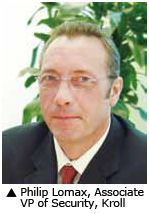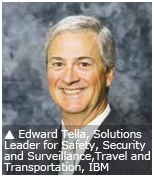Much activity is centered on properly integrating various systems in the infrastructure environment of high-speed rail. As security technologies face rapid development, integration challenges must be surmounted.The most difficult challenge in most projects lies in the integration of systems. “Often, the end user will want to integrate security, fire, elevators, building management and so on,” said Philip Lomax, Associate VP of Security, Kroll. Problems usually arise when some systems are less robust in terms of network protection and access processes. As a result, the integrity of security systems is compromised.
Much activity is centered on properly integrating various systems in the infrastructure environment of high-speed rail. As security technologies face rapid development, integration challenges must be surmounted.
The most difficult challenge in most projects lies in the integration of systems. “Often, the end user will want to integrate security, fire, elevators, building management and so on,” said Philip Lomax, Associate VP of Security, Kroll. Problems usually arise when some systems are less robust in terms of network protection and access processes. As a result, the integrity of security systems is compromised.
Aside from integration, the common goals of safety and security remain the same, whether it is traditional passenger rail or high-speed rail (HSR), said Edward Tella, Solutions Leader for Safety, Security and Surveillance, Travel and Transportation, IBM.
In-station versus Onboard
While advanced solutions provide operators with more accurate visual coverage and operational efficiency with less impact on human resources, different technical challenges exist when it comes to in-station versus onboard solutions, Tella said. “Onboard systems are generally easier to deal with as they are dedicated security solutions and do not integrate with anything else,” Lomax said.
In the security world, environmental, spatial and human factors are not deemed uncontrollable but, rather, calculated risks, Lomax added. “All problems could be resolved with unlimited resources. However, this is never going to be the case, so we mititgate based on what is available and give the highest priority to the risks that have the greatest downstream impact."
Upgrading or retrofitting new equipment at railway stations or onboard trains demands imagination and spatial awareness in order to find the optimum balance, said Dr. Bernard Lottmann, Sales Manager at Building Technologies Division, Siemens.
 Some situations call for the collaboration between architects and integrators. For example, stations that are considered historic monuments call for awareness and familiarity with the environment and technology in order to install front-end devices with adequate illumination without causing damage.
Some situations call for the collaboration between architects and integrators. For example, stations that are considered historic monuments call for awareness and familiarity with the environment and technology in order to install front-end devices with adequate illumination without causing damage.
Resistance is circumvented once operators and users realize an improvement in their daily operations, Lottmann said. “In order to do the job efficiently, operators must naturally be familiarized with all the requirements of the new security system.”
Building Scalability
Security operators often want to increase the quantity of front-end equipment, so the solution must be scalable and modular, Lottmann said. “The degree of integration or sophistication of management software should not be an issue for operators, but administrators should be able to add more cameras and/or change the site map relatively easily.”
Furthermore, scalability is needed to deal with increasing volume of information and advancement of technology, in order to continue producing alerts in real time and perform advanced analytics on recorded data for other applications, Tella said. “We take into account operators' needs for growth, through additional cameras or sensors, while retaining their investment in existing infrastructure.”
 While incorporating scalability for surveillance systems is considered an easier process, that of management systems is not. These systems operate on a software level, with different manufacturers using different proprietary protocols, Lomax said. “However, this can be solved with plug-and-play technology which enables users to add devices easily without major interface issues.”
While incorporating scalability for surveillance systems is considered an easier process, that of management systems is not. These systems operate on a software level, with different manufacturers using different proprietary protocols, Lomax said. “However, this can be solved with plug-and-play technology which enables users to add devices easily without major interface issues.”
Tailored Solutions
There are no specific security solutions targeted at HSR. The alternative is to use what is available on the market, said Chris Lawrence, Head of Security Advisory Services for TPS Consult. In terms of video surveillance, technologies that are valuable to HSR applications are used universally across other business, commercial and transportation applications, added Brian Karas, Director of Field Engineering for VideoIQ.
On the other hand, projects are still dealt with on a case-by-case basis, with solutions catered to particular environments. “When dealing with major networks and the requirements of the operators therein, there is no solution which is continually applicable,” said Mark Marriage, founder and CTO for COE (a Digital Barriers company).
“ Certaine quipment and networking structures would be applicable to multiple projects,“ Marriage continued. “However, the network requirements of the users and a variety of other factors would heavily influence the project design process, and these necessitate each system's design be considered on an individual basis.”
Addressing Issues
 Issues such as long distance, wide area, constant movement and near-24/7 operation must be addressed in order to ensure smooth integration. “Integrating redundancy into the various aspects of system design ensures the systems, which are in constant or near constant use, do not suffer from downtime as a result of individual or multiple devices' failure,” said Marriage. As the rail industry requires video surveillance equipment to be of a higher environmental rating, there are a number of transportation-specific standards that apply, Marriage said. For example, the new Euro Norm specifications, which include rigorous environmental ratings, further ensure that rail products are manufactured and specified to a high quality. “HSR security requires a more frequent maintenance schedule to ensure equipment functions as effectively as possible.”
Issues such as long distance, wide area, constant movement and near-24/7 operation must be addressed in order to ensure smooth integration. “Integrating redundancy into the various aspects of system design ensures the systems, which are in constant or near constant use, do not suffer from downtime as a result of individual or multiple devices' failure,” said Marriage. As the rail industry requires video surveillance equipment to be of a higher environmental rating, there are a number of transportation-specific standards that apply, Marriage said. For example, the new Euro Norm specifications, which include rigorous environmental ratings, further ensure that rail products are manufactured and specified to a high quality. “HSR security requires a more frequent maintenance schedule to ensure equipment functions as effectively as possible.”
Outdoors
In harsh, outdoor environments with challenging climatic conditions, the trend is toward event-driven control rooms using sensor fusion and video/audio analytics, said Richard Lack, Director of Sales and Marketing, Application Solutions (ASL Safety and Security). “There is plenty of evidence suggesting video analytics do operate well in certain outdoor environments when conrrectly specified and configured.”